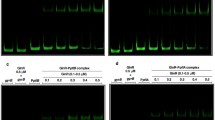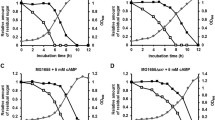Abstract
In Lactobacillus casei BL23, phosphofructokinase activity was higher in cells utilizing sugars transported by the phosphoenolpyruvate:sugar phosphotransferase system (PTS). The phosphofructokinase gene (pfk) was cloned from L. casei and shown to be clustered with the gene encoding pyruvate kinase (pyk). pfk and pyk genes are cotranscribed and induced upon growth on sugars transported by the PTS. Contrarily to the model proposed for Lactococcus lactis, where the global catabolite regulator protein (CcpA) is involved in PTS-induced transcription of pfk and pyk, a ccpA mutation resulted in a slight increase in pfk–pyk expression in L. casei. This weak regulation was evidenced by CcpA binding to a region of the pfk–pyk promoter which contained two cre sequences significantly deviated from the consensus. The PTS induction of pfk–pyk seems to be counteracted by the CcpA-mediated repression. Our results suggest that the need to accommodate the levels of pfk–pyk mRNA to the availability of sugars is fulfilled in L. casei by a PTS/CcpA-mediated signal transduction different from L. lactis.




Similar content being viewed by others
References
Asanuma N, Yoshii T, Hino N (2004) Molecular characterization of CcpA and involvement of this protein in transcriptional regulation of lactate dehydrogenase and pyruvate formate-lyase in the ruminal bacterium Streptococcus bovis. Appl Environ Microbiol 70:5244–5251
Blencke HM, Homuth G, Ludwig H, Mader U, Hecker M, Stülke J (2003) Transcriptional profiling of gene expression in response to glucose in Bacillus subtilis: regulation of the central metabolic pathways. Metab Eng 5:133–149
van den Bogaard PTC, Kleerebezem M, Kuipers OP, de Vos WM (2000) Control of lactose transport, β-galactosidase, and glycolysis by CcpA in Streptococcus thermophilus: evidence for carbon catabolite repression by a non-phosphoenolpyruvate-dependent phosphotransferase system sugar. J bacteriol 182:5982–5989
Branny P, De La Torre F, Garel JR (1993) The genes for phosphofructokinase and pyruvate kinase of Lactobacillus delbrueckii subsp. bulgaricus constitute an operon. J Bacteriol 178:4727–4730
Chen JD, Morrison DA (1988) Construction and properties of a new insertion vector, pJDC9, that is protected by transcriptional terminators and useful for cloning of DNA from Streptococcus pneumoniae. Gene 64:155–164
Crispie F, Anba J, Renault P, Ehrlich D, Fitzgerald G, van Sinderen D (2002) Identification of a phosphofructokinase-encoding gene from Streptococcus thermophilus CNRZ1205–a novel link between carbon metabolism and gene regulation?. Mol Genet Genomics 268:500–509
Daldal F (1983) Molecular cloning of the gene for phosphofructokinase-2 of Escherichia coli and the nature of a mutation, pfkB1, causing a high level of the enzyme. J Mol Biol 168:285–305
Deutscher J, Küster E, Bergstedt U, Charrier V, Hillen W (1995) Protein kinase-dependent HPr/CcpA interaction links glycolytic activity to carbon catabolite repression in gram-positive bacteria. Mol Microbiol 15:1049–1053
Deutscher J, Galinier A, Martin-Verstraete I (2002) Carbohydrate uptake and metabolism. In: Sonenschein AL, Hoch JA, Losick R (eds) Bacillus subtilis and its closest relatives: from genes to cells. American Society for Microbiology Press, Washington, pp 129–150
Doan T, Aymerich S (2003) Regulation of the central glycolytic genes in Bacillus subtilis: binding of the repressor CggR to its single DNA target sequence is modulated by fructose-1,6-bisphosphate. Mol Microbiol 47:1709–1721
Dossonnet V, Monedero V, Zagorec M, Galinier A, Pérez-Martínez G, Deutscher J. (2000) Phosphorylation of HPr by the bifunctional HPr Kinase/P-ser-HPr phosphatase from Lactobacillus casei controls catabolite repression and inducer exclusion but not inducer expulsion. J Bacteriol 182:2582–2590
Even S, Lindley ND, Cocaign-Bousquet M (2001) Molecular physiology of sugar catabolism in Lactococcus lactis IL1403. J Bacteriol 183:3817–3824
Even S, Lindley ND, Cocaign-Bousquet M (2003) Transcriptional, translational and metabolic regulation of glycolysis in Lactococcus lactis subsp. cremoris MG1363 grown in continuous acidic cultures. Microbiology 149:1935–1944
Fujita Y, Miwa Y, Galinier A, Deutscher J (1995) Specific recognition of the Bacillus subtilis gnt cis-acting catabolite-responsive element by a protein complex formed between CcpA and seryl-phosphorylated HPr. Mol Microbiol 17:953–960
Galinier A, Kravanja M, Engelmann R, Hengstenberg W, Kilhoffer MC, Deutscher J, Haiech J (1998) New protein kinase and protein phosphatase families mediate signal transduction in bacterial catabolite repression. Proc Natl Acad Sci USA 95:1823–1828
Gosalbes MJ, Monedero V, Alpert CA, Pérez-Martínez G (1997) Establishing a model to study the regulation of the lactose operon in Lactobacillus casei. FEMS Microbiol Lett 148:83–89
Griffin HG, I’Anson KJ, Gasson MJ (1993) Rapid isolation of genes from bacterial lambda libraries by direct polymerase chain reaction screening. FEMS Microbiol Lett 112:49–53
Kandler O (1983) Carbohydrate metabolism in lactic acid bacteria. Antonie Van Leeuwenhoek 49:209–224
Klaenhammer T, Altermann E, Arigoni F, Bolotin A, Breidt F, Broadbent J, et al. (2002) Discovering lactic acid bacteria by genomics. Antonie Van Leeuwenhoek 82:29–58
Koebmann B, Solem C, Jensen PR (2005) Control analysis as a tool to understand the formation of the las operon in Lactococcus lactis. FEBS J 272:2292–2303
Kravanja M, Engelmann R, Dossonnet V, Bluggel M, Meyer HE, Frank R, et al. (1999) The hprK gene of Enterococcus faecalis encodes a novel bifunctional enzyme: the HPr kinase/phosphatase. Mol Microbiol 31:59–66
Leboeuf C, Leblanc L, Auffray Y, Hartke A (2000) Characterization of the ccpA gene of Enterococcus faecalis: identification of starvation-inducible proteins regulated by CcpA. J Bacteriol 182:5799–5806
Leloup L, Ehrlich SD, Zagorec M, Morel-Deville F (1997) Single-crossover integration in the Lactobacillus sake chromosome and insertional inactivation of the ptsI and lacL genes. Appl Environ Microbiol 63:2117–2123
Llanos RM, Harris CH, Hillier AJ, Davidson BE (1993) Identification of a novel operon in Lactococcus lactis encoding three enzymes for lactic acid synthesis: phosphofructokinase, pyruvate kinase, and lactate dehydrogenase. J Bacteriol 175:2541–2551
Ludwig H, Homuth G, Schmalisch M, Dyka FM, Hecker M, Stülke J (2001) Transcription of glycolytic genes and operons in Bacillus subtilis: evidence for the presence of multiple levels of control of the gapA operon. Mol Microbiol 41:409–422
Ludwig H, Rebhan N, Blencke HM, Merzbacher M, Stülke J (2002) Control of the glycolytic gapA operon by the catabolite control protein A in Bacillus subtilis: a novel mechanism of CcpA-mediated regulation. Mol Microbiol 45:543–553
Luesink EJ, van Herpen RE, Grossiord BP, Kuipers OP, de Vos WM (1998) Transcriptional activation of the glycolytic las operon and catabolite repression of the gal operon in Lactococcus lactis are mediated by the catabolite control protein CcpA. Mol Microbiol 30:789–798
Luesink EJ, Beumer CM, Kuipers OP, De Vos WM (1999) Molecular characterization of the Lactococcus lactis ptsHI operon and analysis of the regulatory role of HPr. J Bacteriol 181:764–771
Mahr K, Esteban CD, Hillen W, Titgemeyer F, Pérez-Martínez G (2002) Cross communication between components of carbon catabolite repression of Lactobacillus casei and Bacillus megaterium. J Mol Microbiol Biotechnol 4:489–494
Monedero V, Gosalbes MJ, Pérez-Martínez G (1997) Catabolite repression in Lactobacillus casei ATCC 393 is mediated by CcpA. J Bacteriol 179:6657–6664
Moreno MS, Schneider BL, Maile RR, Weyler W, Saier MH (2001) Catabolite repression mediated by the CcpA protein in Bacillus subtilis: novel modes of regulation revealed by whole-genome analyses. Mol Microbiol 39:1366–1381
Nguyen CC, Saier MH (1995) Phylogenetic analysis of the putative phosphorylation domain in the pyruvate kinase of Bacillus stearothermophilus. Res Microbiol 146:713–719
Posno M, Leer RJ, van Luijk N, van Giezen MJF, Heuvelmans PTHM, Lokman BC, Pouwels PH (1991) Incompatibility of lactobacillus vectors with replicons derived from small cryptic lactobacillus plasmids and segregational instability of the introduced vectors. Appl Environ Microbiol 57:1822–1828
Postma PW, Lengeler JW, Jacobson GR (1993) Phosphoenolpyruvate:carbohydrate phosphotransferase systems of bacteria. Microbiol Rev 57:543–594
Sambrook J, Fritsch EF, Maniatis T (1989). Molecular cloning: a laboratory manual, 2nd edn. Cold Spring Harbor Laboratory Press, Cold Spring Harbor
Takahashi N, Kalfas S, Yamada T (1995) Phosphorylating enzymes involved in glucose fermentation of Actinomyces naeslundii. J Bacteriol 177:5806–5811
Titgemeyer F, Hillen W (2002) Global control of sugar metabolism: a gram-positive solution. Antonie Van Leeuwenhoek 82:59–71
Veyrat A, Monedero V, Pérez-Martínez G (1994) Glucose transport by the phosphoenolpyruvate:mannose phosphotransferase system in Lactobacillus casei ATCC 393 and its role in carbon catabolite repression. Microbiology 140:1141–1149
Viana R, Monedero V, Dossonnet V, Vadeboncoeur C, Pérez-Martínez G, Deutscher J (2000) Enzyme I and HPr from Lactobacillus casei: their role in sugar transport, carbon catabolite repression and inducer exclusion. Mol Microbiol 36:570–584
Yebra MJ, Veyrat A, Santos MA, Pérez-Martínez G (2000) Genetics of L-sorbose transport and metabolism in Lactobacillus casei. J Bacteriol 182:155–163
Acknowledgements
We thank CD Esteban for pET plasmids expressing L. casei CcpA and HPr. Manuel Zúñiga is acknowledged for valuable discussions. This work was supported by the BIO4-CT96-0380 European project and by funds of the Spanish Ministerio de Educación y Ciencia (Project BIO2001-01616). Genome sequencing of L. casei BL23 was carried out at the University of Caen, Laboratoire de Microbiologie de l’Environnement and at the INRA Thiverval-Grignon, Microbiologie et Génétique Moléculaire, with the financial aide from the Region Basse Normandie and the INRA. RV was recipient of a fellowship from the Ministerio de Educación y Ciencia from Spain.
Author information
Authors and Affiliations
Corresponding author
Rights and permissions
About this article
Cite this article
Viana, R., Pérez-Martínez, G., Deutscher, J. et al. The glycolytic genes pfk and pyk from Lactobacillus casei are induced by sugars transported by the phosphoenolpyruvate:sugar phosphotransferase system and repressed by CcpA. Arch Microbiol 183, 385–393 (2005). https://doi.org/10.1007/s00203-005-0003-6
Received:
Revised:
Accepted:
Published:
Issue Date:
DOI: https://doi.org/10.1007/s00203-005-0003-6




